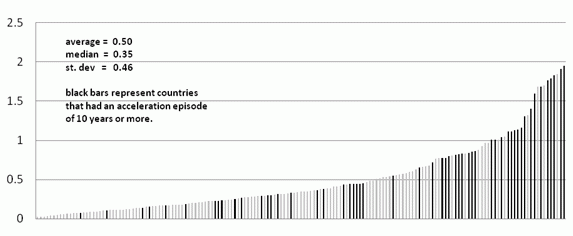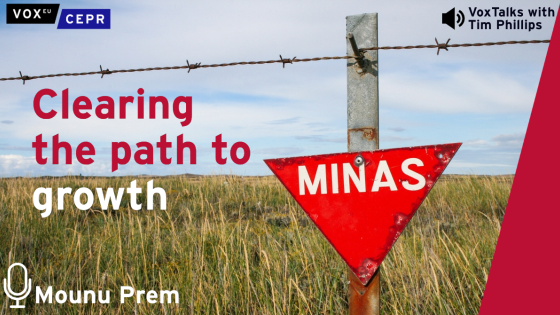The epicentre of the global crisis can be traced to the world’s most developed financial systems, but few would consider this enough to challenge the broad consensus that financial development is good for economic growth. Yet despite this consensus, levels of financial development vary widely across countries (Figure 1), and many governments have failed to jumpstart their country’s financial markets.
Figure 1. Cross-country disparities in the ratio of credit to private sector GDP (2005) (each bar represents a country)
These observations have led to a decades of research on the right policies and institutional features conducive to financial development.
First, after a few decades of financial repression, financial liberalisation was considered the key to success. Industrialised countries led the reform efforts in the 1970s, followed by many middle- and low-income countries. The resulting mixed outcomes gradually made clear that liberalisation, while necessary, was not a sufficient condition for financial development and that other factors, such as the quality of institutions, might be critical to ensure success. One body of research has focused on differences in legal origin among countries but empirical results have remained inconclusive. Effective enforcement of property rights has subsequently been singled out as an institution contributing to financial development (Acemoglu and Johnson 2005) – more so than other legal institutions.
Who protects property right protection?
This finding, however important, begs the question, what is the ultimate source of effective protection of property rights? A number of authors have argued that political institutions represent this ultimate source. They argue that effective protection of property rights can only be established in an environment where political institutions are willing to limit their own powers, through systems of checks and balances (Haber et al. 2008). Political institutions that provide checks and balances instil the necessary confidence in market participants that allows a country’s financial system to develop healthily. So far, a limited number of studies have supported this view (see Bordo and Rousseau (2006), Keefer (2008), Roe and Siegel (2008) and Tressel and Detragiache (2008).
In a recent paper (Quintyn and Verdier 2010), we test this hypothesis and find that most long-lasting episodes of financial deepening indeed have occurred in countries with high-quality political institutions.
Our research analyses a standard measure of financial development – the ratio of private sector credit to GDP – from a different perspective than the typical time-series analysis. For a sample of 160 countries over the period 1960-2005 we identify periods during which countries experienced an acceleration in financial development. We identify a total of 209 such accelerations – defined as the ratio growing more than 2% annually for a minimum of 5 years – and estimate the impact of economic and institutional conditions around the take-off, on the likelihood of such an event. Episodes of financial acceleration range in length from 5 years (the imposed minimum) to as long as 22 years. Obviously, the nature of these periods can be different. The literature generally identifies three types of accelerations:
- Type 1. At beginning of a cyclical upturn, credit typically expands faster than output, due to the need to finance investments and higher working capital. Such episodes are associated with the working of the conventional accelerator;
- Type 2. Excessive credit expansions or “credit booms” may result from inappropriate responses of market participants to changes in risks over time, sometimes following financial liberalisation. In the best case, the boom comes to a soft landing, in the worst case it results in a banking (and real sector) crisis;
- Type 3. Longer periods of “financial deepening”, with rates of expansion of the financial system typically lower than type 1 or 2, but sustainable for a longer period of time, leading to a more sophisticated financial system.
To test the political-institutions hypothesis, we have a special interest in analysing the conditions under which sustained accelerations (type 3) are likely to occur. Based on the literature on lending booms, we identify ype-3 takeoffs as those lasting 10 years or longer, allowing us to compare the prevailing economic and institutional conditions at the start of short-lived and longer-lived periods of financial deepening.1 Of the 209 episodes, 161 are short episodes and 48 are long one – just over one-fifth of the total.
The significance of having experienced (at least) one long episode of financial acceleration for financial development is obvious from Figure 1. A majority of countries that now have highly developed financial systems experienced a long episode of acceleration (black bars) at some point over the past 50 years. On the other hand, a sustained acceleration is no guarantee for success as reversals seem to have occurred in a number of countries.
What is the probability of a financial take-off in a given country?
How does an episode of financial acceleration become a period of financial deepening? We consider the hypothesis that a set of factors – macroeconomic variables (real GDP growth, inflation, GDP per capita), financial reforms (index of financial liberalisation from Tressel and Detragiache, 2008), the quality of political institutions (from Polity IV) – explain the probability of a take-off at time t. The dependent variable in our probit analysis is a dummy that is 1 in the years associated with a financial acceleration and 0 otherwise.2 All explanatory variables are lagged to reduce the risk of endogeneity.
Our main results, summarised in Table 1, show that the drivers of short and long episodes are different. Financial liberalisation has a significant and large impact on the probability of a take-off. However, the effect differs according to the duration of the take-off. The likelihood of a short episode increases significantly following successive efforts to liberalise the financial system. In contrast, mainly contemporaneous financial liberalisation seems to matter for long episodes. The impact of improved bank supervision seems rather weak across the board.
Our results lend strong support for the political institutions view. The Polity variable has a significant and negative effect on the probability of a take-off lasting less than ten years and, contrasting with this, a significant and positive impact on sustained episodes of financial development. This suggests that countries with checks and balances in the political system are more likely to experience genuine financial deepening. Recent regime changes (positive or negative) do not seem to increase the likelihood of short or long episodes significantly.3 This confirms that political stability and a confidence-enhancing institutional setup are important for financial development.
Table 1. Overview of main regression results – likely determinants of financial accelerations
|
|
Accelerations lasting
5 – 10 yrs
|
Accelerations lasting
> 10 yrs
|
Accelerations lasting
5 – 10 yrs
|
Accelerations lasting
> 10 yrs
|
|
Real economic growth
|
+***
|
+ **
|
+***
|
+ **
|
|
Financial liberalisation
|
+ ***
|
+ **
|
+ ***
|
+ **
|
|
Financial liberalisation (-1)
|
+***
|
+
|
+ ***
|
+
|
|
Financial liberalisation (-2)
|
+***
|
+*
|
+***
|
+**
|
|
Bank supervision
|
-
|
+
|
-
|
+
|
|
Polity
|
- ***
|
+ **
|
|
|
|
Durability Democracy
|
|
|
- *
|
+ ***
|
|
Durability Autocracy
|
|
|
+
|
-
|
|
Positive regime change
|
+
|
-
|
+
|
-
|
|
Negative regime change
|
+
|
+
|
+ *
|
+
|
|
Credit/GDP
|
- ***
|
- ***
|
- ***
|
- ***
|
|
GDP/capita
|
+***
|
+ ***
|
+***
|
+ ***
|
To further investigate the importance of political stability for financial development, we also considered the durability of the political regime. The results (two columns to the right in table 1 show that the durability of a democratic regime, in other words, a combination of stability and quality of the polity, greatly increases the probability of a sustained period of financial development.
Conclusion
We find that financial liberalisation emerges as a very strong driver for short-term financial accelerations but is not sufficient for sustained deepening of the financial sector. It is the quality of the political institutions and the stability (or durability) of such institutions that strongly increases the probability of sustained financial deepening. In other words, while financial liberalisation is likely to ignite accelerations, these only become long-term events in an environment where political competition and checks and balances provide enough guarantees to market participants that financial promises will be kept and the government will not overrule property rights.
References
Acemoglu, Daron and Simon Johnson (2005), “Unbundling Institutions”, Journal of Political Economy, 113:949-995.
Bordo, Michael and Peter Rousseau (2006), “Legal-Political Factors and the Historical Evolution of the Finance-Growth Link”, NBER Working Paper 12035.
Campos, Nauro and Fabrizio Coricelli (2009), “Financial Liberalization and Democracy: The Role of Reform Reversals”, CEPR Discussion Paper 7393, 41pp.
Gourinchas, Pierre-Olivier, Rodrigo Valdés and Oscar Landerretche (2001), “Lending Booms: Latin America and the World”, Economia, Spring, 47-99.
Haber, Stephen, Douglass North and Barry Weingast (2008), Political Institutions and Financial Development, 1-9 in Haber, Stephen, Douglass North and Barry Weingast (2008), Political Institutions and Financial Development, Stanford University Press.
Hilbers, Paul, Inci Otker-Robe, Ceyla Pazarbasioglu and Gudrun Johnsen (2005), “Assessing and Managing Rapid Credit Growth and the Role of Supervisory and Prudential Policies”, IMF Working Paper 05/151.
Keefer, Philip (2008), “Beyond Legal Origin and Checks and Balances: Political Credibility, Citizen Information and Financial Sector Development”, 125-155, in Haber,
Stephen, Douglass North and Barry Weingast (2008), Political Institutions and Financial Development, Stanford University Press.
Quintyn, Marc and Geneviève Verdier (2010), ““Mother, can I trust the Government?” Sustained Financial Deepening – A Political Institutions View”, IMF Working Paper 10/210
Roe, Mark, and Jordan Siegel (2008), “Political Instability: Its Effects on Financial Development, Its Roots in the Severity of Economic Inequality”, SSRN, July.
Tressel, Thierry and Enrica Detragiache (2008), “Do Financial Reforms Lead to Financial Development? Evidence from a New Dataset”, IMF Working Paper 08/265.
1 Gourinchas et al. (2001) estimate that the average lifetime of a lending boom (our type 2) is 6.7 years, with a standard deviation of 3.6. Hilbers et al. (2005) find that credit booms ending in a crisis last on average 6.8 years, while those ending without a crisis have a lifetime of, on average 9.6 years.
2 We also assign a value of 1 to the year before and after the take off to minimise the possibility that we have mis-timed the beginning of an episode.
3 This finding is consistent with Campos and Coricelli (2009), who find that financial development did not take off in the first years of the transition to democracy in CIS and CEE countries, because quite often political conditions were more chaotic in those years than in the preceding years.




